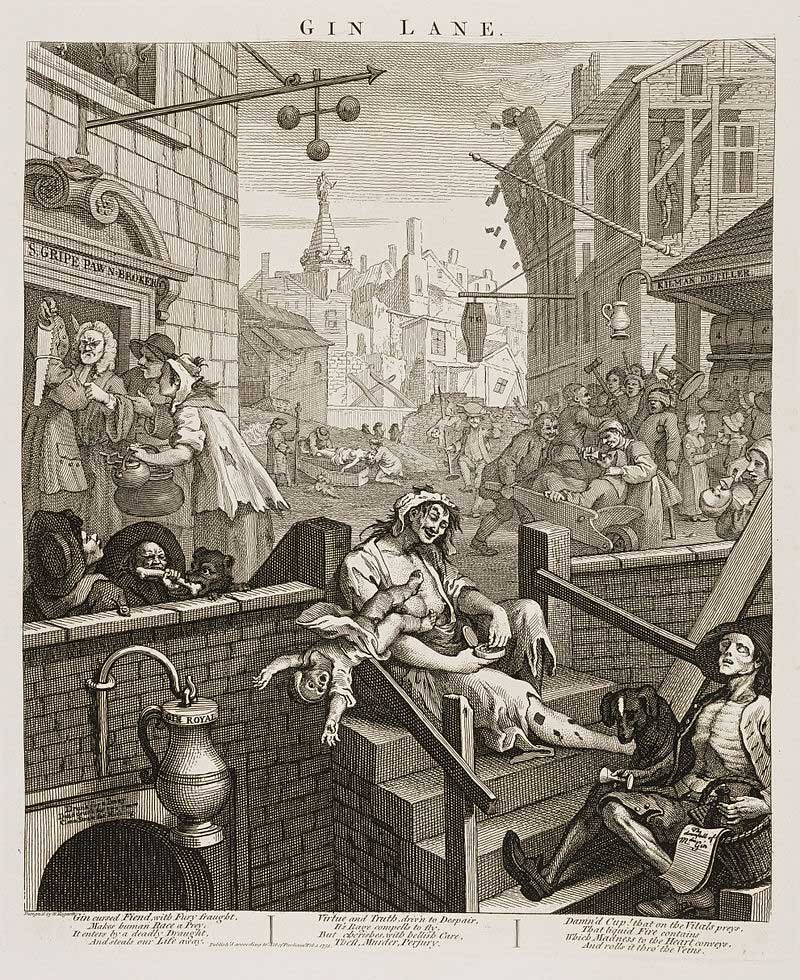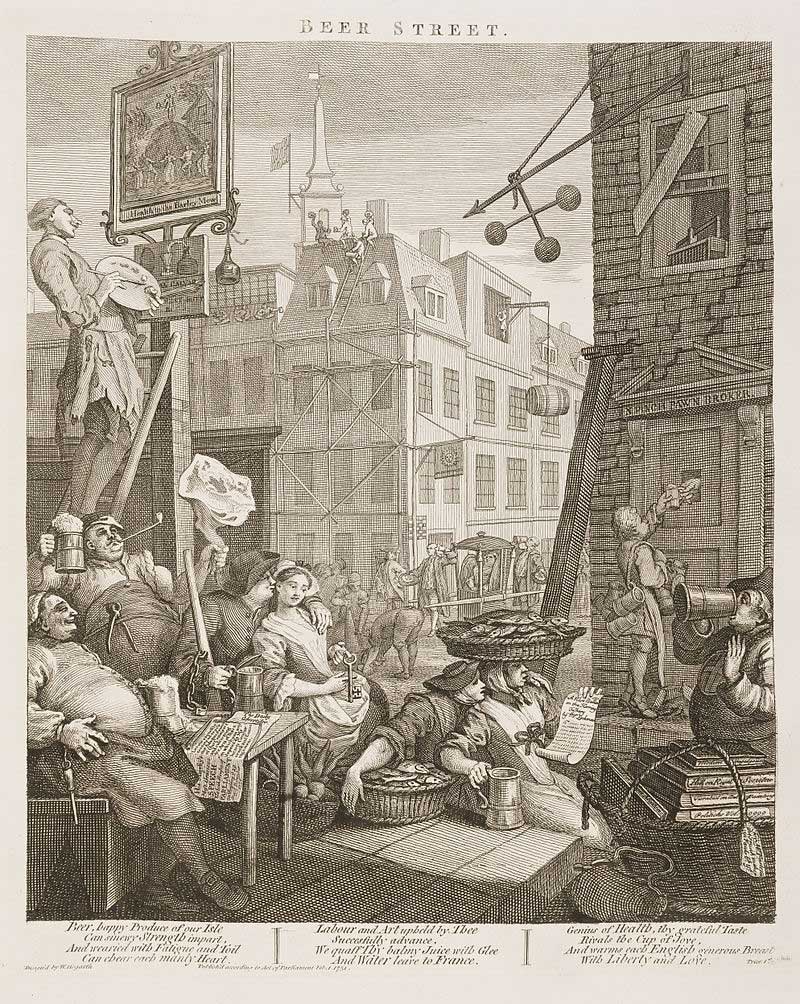Maybe not everyone knows that beer and gin have been bitter enemies throughout modern history, despite themselves and obviously because of politics.
The starting point for resolving the matter is undoubtedly the two prints of William Hogarth of the 1751, Beer Street and Gin Lane, where these two alcoholic drinks are ascribed to two different, decidedly antithetical models of society.
Gin Lane represents the degradation of the moral and sexual mores of gin drinkers in mid-eighteenth-century London.
At the center of the scene we see a mother - that is, a prostitute with legs plagued by syphilis - who lets her son fall without caring about the death he will find at the bottom of the marble staircase where she lies, half-dressed and drunk on gin, in the middle of the public square.
Bloody depiction, you might think; but in that period, not at all gone down in history as Gin Craze, statistics estimate an average annual consumption of gin of around an average of 10 liters per person, in England alone.
As one can easily imagine, gin had become a significant public problem; and so at that point politics - and intellectuals such as Hogart or Daniel Defoe - attempted to contrast the degradation resulting from the mass public abuse of gin with what in that era - and above all in that context - seemed like public consumption healthy and socially acceptable, that of beer.
Taking into account that at that time a beer could simply be more drinkable and less dirty than a glass of water, for that matter.
So here are the characters of Beer Street instead they are all workers fully integrated into society, who stop just long enough to rest from their daily chores while peacefully drinking their nice beer. They are all fat and satisfied, in full health.
But stopping at this slide doesn't tell the whole story.
It is politics that generated this contrast between beer and gin, and the motive that animated it was - as often happens - of an exquisitely economic nature.
Gin vs. Beer. William III of Orange's English alcohol policy
Broadening the perspective lens we can state that the 'war' between beer and gin in modern England originates with the arrival of William III of Orange on the throne in 1689, and finds its resolution only in the late Victorian age, when the new laws on alcohol sales licenses put an end to the 'moral question' that had seen the two alcoholic beverages pitted against each other.
The introduction of mass consumption of gin was directly favored with the arrival of the Orangemen, when the government curbed imports of brandy from France and instead encouraged the distillation of gin, which then quickly caught on even at popular levels.
Starting from 1736 and until 1751 the government attempted to retrace its steps, given that in the meantime the Gin Craze and the situation depicted in Hogarth's Gin Lane print had arrived. With the Gin Acts limitations on distillation and production were reintroduced direct sales of gin, often in the form of taxes aimed at those entrepreneurs who in the meantime had made the retail gin trade theirs business principal.
Obviously these control and prohibition measures had the main effect of fueling the black market in gin, a phenomenon which obviously could only fuel the episodes of public violence connected to the consumption and trade of the distillate.
The Gin Craze, historians quite agree on this, was temporarily resolved with the economic crises of the end of the century, which on the other hand served as a context for the migratory phenomena towards the United States through which Europe could at that time get rid of the disadvantaged social strata who were freed from the countryside and who were unable to find a stable place in the new urban-industrial economy, which constituted the backbone of English society of what would soon become the Victorian era.
But even then, if we limited ourselves to macroeconomic analysis, we would only have part of the story.
In fact, the Gin Acts of the mid-eighteenth century had the indirect effect of selecting a class of merchants who were becoming willing to invest in gin and its public consumption.
Gin Palace Vs. Beer House. The historical origins of the Victorian pub
It is no coincidence that after a couple of generations we will discover that, starting from 1820, the public trade in gin has regained strength, to the point of seeing the appearance - first in London and then throughout the country - of the first Gin Palace.
Here you are. Gin Palaces are precursors to Victorian pubs which then shape the concept of pubs that we still have in the common imagination today; but before accepting this influence we must also understand that the opposition between beer and gin by the English government was not yet over.
The Gin Palaces had very modern elements that would later be taken up by pubs, such as certainly the large wooden counter where gin was served to customers, who consumed it standing or on high stools against the counter.
Among other things, the Gin Palaces were among the first public places in London at the time to install gas lamps for evening lighting, an element that could certainly only emerge in a business context that was anything but improvised; but nevertheless such places were still frowned upon by the English government - as well as by the rich bourgeoisie and educated public opinion, who considered them 'vulgar' places and managed by subjects who today we would define as 'border line', with respect to legality and morality.
So in 1830 the Beer Act, with which the English government encourages the public sale of beer by ordinary citizens; who will be authorized - in fact - to pour beer at their home without the need for a license, having the customers pay for the drink.
Naturally the owner of the house could not serve alcohol of any other kind; only and exclusively beer.
This political act therefore gave birth to the Beer House, which spread like wildfire throughout England and effectively managed to remove a large segment of customers from gin and Gin Palaces, at least partially limiting the phenomena of public drunkenness.
But above all it was the gin connoisseurs who now went to the Gin Palaces who were no longer part of the poor populace.
Let us consider that the column still was invented towards the end of the 1820s, in fact, and without it the distillation of the first London Dry Gin of history would not have been possible.
Starting from the Victorian age, beer took on the role of 'public alcohol for the masses', economical and socially sustainable, while gin begins to find its place among the 'noble' spirits, shaping its tradition and intercepting a consumer audience that is now totally urban and 'bourgeois'.
Starting from 1869, controls were reintroduced on the public sale of beer and other liqueurs and within a very short time the various Beer Houses in England were forced to obtain a normal sales license and lose the 'homemade' dimension that had initially characterized, then transforming them into real ones public places for the consumption of alcoholic beverages. All alcoholic drinks, this time; beer, obviously, but also gin, wine and all other high-alcohol spirits.
And the Wine and Beerhouse Act which truly closes the contrast between beer and gin depicted by Hogarth in 1751, with the prints mentioned at the beginning. After 1869, Victorian pubs inherited elements, skills and designs from both Gin Palaces and Beer Houses, forging a commercial tradition that is still passed down over the centuries.








